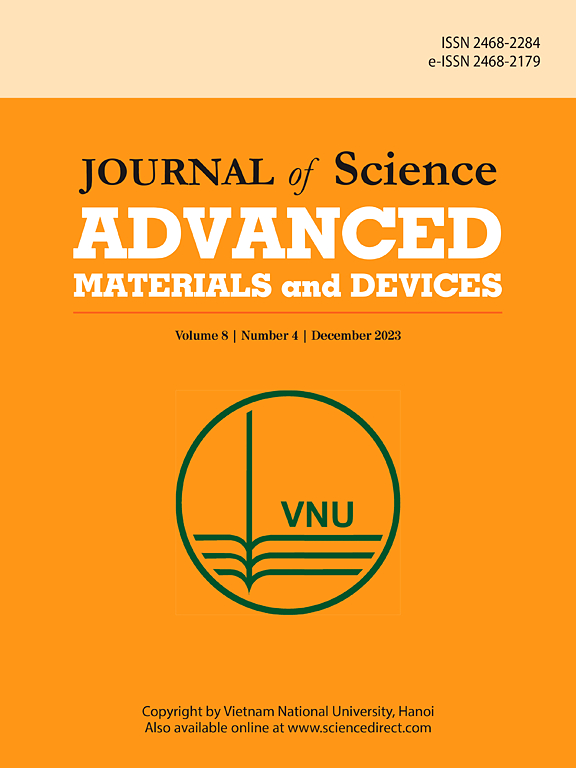Magnetically tunable 4 × 2 encoder utilizing Terfenol-D-embedded phononic crystal ring resonators
IF 6.7
3区 材料科学
Q1 MATERIALS SCIENCE, MULTIDISCIPLINARY
Journal of Science: Advanced Materials and Devices
Pub Date : 2025-02-06
DOI:10.1016/j.jsamd.2025.100861
引用次数: 0
Abstract
The research nominates an innovative magnetically tunable 4×2 encoder structure that utilizes ring resonators and Terfenol-D tubes embedded inside a robust phononic crystal made of solid materials. The proposed method takes advantage of the variable magnetic field strengths of Terfenol-D in the MHz frequency spectrum through wave interference techniques. The encoder system is designed as a two-dimensional phononic crystal, using poly methyl methacrylate as the foundational material, and integrates a square arrangement of circular tungsten tubes. The encoder features an ultra-compact footprint of 125 × 10-6 m2, with four input waveguides and two output waveguides, each equipped with a pair of ring resonators. The smaller cavities are coupled with curved two-branch waveguides, optimizing wave interference while minimizing losses and scattering to achieve enhanced performance. Each ring resonator incorporates three integrated Terfenol-D tubes, which modulate their Young's modulus properties. The symmetrical design of the structure enables the generation of distinct resonant frequencies under varying magnetic field intensities. The resonance frequencies of the ring resonators, along with the dynamic adjustment of the Terfenol-D cylinders, significantly influence the encoder's operational efficiency and tunability. Tunability experiments are conducted for three distinct Young's modulus values of Terfenol-D, corresponding to three various magnetic fields, resulting in resonance frequencies of 1.7388 MHz, 1.7389 MHz, and 1.7390 MHz. The encoder's performance was assessed through the application of the finite element method, yielding an average contrast ratio of 10.16 dB. This proposed encoder offers a straightforward and effective solution for acoustic communication systems and networks, demonstrating significant potential for practical applications.
求助全文
约1分钟内获得全文
求助全文
来源期刊

Journal of Science: Advanced Materials and Devices
Materials Science-Electronic, Optical and Magnetic Materials
CiteScore
11.90
自引率
2.50%
发文量
88
审稿时长
47 days
期刊介绍:
In 1985, the Journal of Science was founded as a platform for publishing national and international research papers across various disciplines, including natural sciences, technology, social sciences, and humanities. Over the years, the journal has experienced remarkable growth in terms of quality, size, and scope. Today, it encompasses a diverse range of publications dedicated to academic research.
Considering the rapid expansion of materials science, we are pleased to introduce the Journal of Science: Advanced Materials and Devices. This new addition to our journal series offers researchers an exciting opportunity to publish their work on all aspects of materials science and technology within the esteemed Journal of Science.
With this development, we aim to revolutionize the way research in materials science is expressed and organized, further strengthening our commitment to promoting outstanding research across various scientific and technological fields.
 求助内容:
求助内容: 应助结果提醒方式:
应助结果提醒方式:


